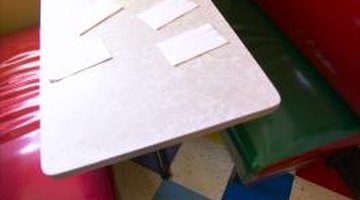How to Hang Upholstered Bench Seat Backs
An upholstered bench seat back is essentially a wooden plank or piece of plywood that has been covered with padding and fabric to create a comfortable back rest. The upholstered seat back may be attached directly to the bench's back rest with screws installed from the back of the bench. To create a dining nook using backless benches, however, the seat back must be attached to the wall. This requires specialized hardware called a hanging cleat. The cleat is a set of U-shaped tracks that are installed on the wall and seat back. The installed tracks interlock to securely attach the seat back to the wall.

Step 1
Measure and mark the center of the upper edge of the upholstered bench seat back. Position the bench seat back on the wall where you intend to install it. Use a carpenter's level to level the seat back. Transfer the center mark from the seat back to the wall with a chalk pencil. Trace a horizontal line on the wall, indicating the position of the upper edge of the seat back. Remove the seat back.
Step 2
Mark a horizontal line across the back of the bench seat back 3 inches from its upper edge. Mark a horizontal line on the wall 3 inches below the previously scribed horizontal line. Measure and mark the centers of both pieces of the hanging cleat.
Step 3
Lay the bench-seat back upholstered-side down on a flat surface. Position the cleat horizontally on the seat back. Align the center of the cleat to the center of the seat back. The open side of the U-shaped faces downward and the articulating surface of the track is aligned to the horizontal line on the seat back. Pass the tip of a pencil through the screw holes on the cleat to mark pilot-hole positions on the seat back. Remove the cleat.
Step 4
Drill a pilot hole through each screw-hole mark on the seat back. Avoid drilling completely through the wood. Reposition the cleat on the seat back, aligning the screw holes in the cleat to the pilot holes. Screw the cleat to the bench seat back.
Step 5
Position the other portion of the cleat on the wall, aligning the center of the cleat to the center mark on the wall. The open side of the U-shaped track faces upward, and the articulating surface of the track is aligned to the horizontal line wall. Pass the tip of a pencil through the screw holes on the cleat to mark pilot-hole positions on the wall. Remove the cleat.
Step 6
Drill a pilot hole through each screw-hole mark on the wall. The cleat should be attached to at least two framing studs. If you don't drill into framing studs, install winged wall anchors in the pilot holes at the ends and center of the cleat. Reposition the cleat on the wall, aligning the screw holes in the cleat with the pilot holes or wall anchors. Screw the cleat to the anchors with a drill and driving bit.
Step 7
Lift the seat back and hold it parallel to the wall, 1 to 2 inches above the cleat installed on the wall. Slide the seat back downward so the two tracks of the hanging cleat set interlock, securely holding the upholstered bench seat back on the wall. Wipe away any visible chalk marks.
Writer Bio
Denise Nyland "Denisen" is a long term resident of Panama City, Fla. She studied radiologic sciences and education and has published articles in multiple professional journals and contributed to various educational texts.
Photo Credits
- Jupiterimages/Photos.com/Getty Images
More Articles



